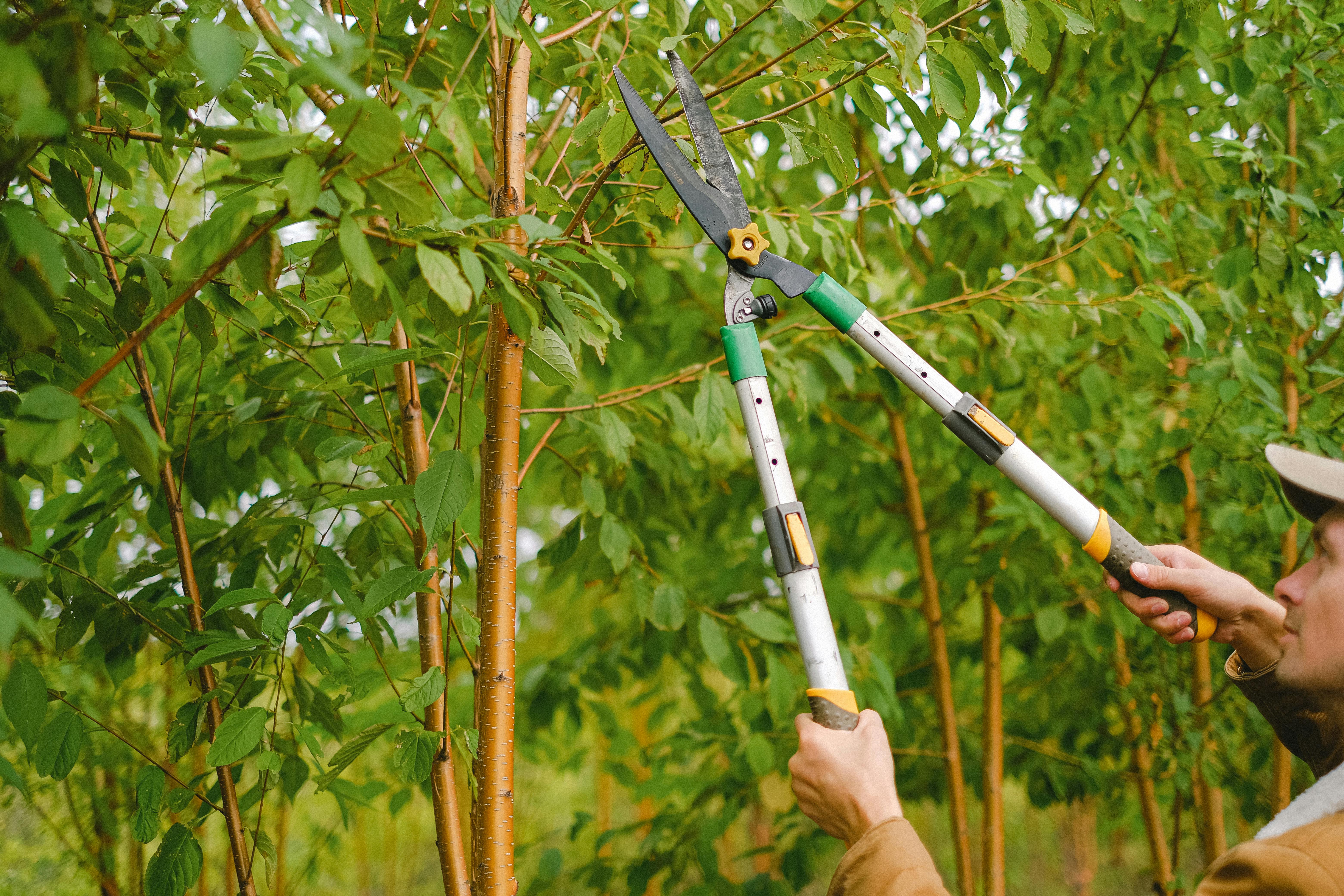Snake plants are an incredibly popular and easy-to-care-for houseplant. While they don’t require much maintenance, one task you may need to perform is trimming a snake plant. Trimming a snake plant is a simple process that can help keep your plant healthy and looking its best. In this article, we’ll provide step-by-step instructions on how to trim a snake plant safely and effectively.1. Choose a pair of scissors that have sharp blades.
2. Cut the leaves off at the base, near the soil line.
3. Make sure to cut off only 1/3 of the leaf blade at a time, as cutting too much can damage the plant.
4. Carefully remove any brown or yellow leaves as these can be signs of stress or disease in your snake plant.
5. Trim off any leaves that are leaning away from their upright position and are growing out of the shape you want to maintain for your plant.
6. After trimming, check for any pests or diseases and treat accordingly if necessary.
7. Place your snake plant back in its desired spot and water as usual to help it recover from being trimmed and adjust to its new shape.
Preparing To Trim A Snake Plant
Trimming a snake plant is a great way to keep it healthy and looking its best. Before you start trimming, there are a few steps you should take to ensure the process goes smoothly. First, make sure the snake plant is healthy and free of any pests or diseases. Check for areas of yellowing or wilting, which may indicate a problem. If you notice any signs of distress, treat the plant before proceeding with trimming.
Next, gather the necessary tools for trimming your snake plant. You will need sharp scissors or pruning shears, as well as gloves and protective eyewear. It’s also important to have a clean work surface where you can place the cuttings after trimming.
Finally, consider how much you would like to trim your snake plant. If it is getting too large for its pot or has grown out of shape, you can trim away some of the bulkier leaves and stems. Alternatively, if you want to give it a more manicured look, simply snip away any browning or discolored leaves from the ends of the stems with scissors or pruning shears.
Once all these steps are complete, you’re ready to start trimming your snake plant! Make sure to take your time and be gentle when handling the delicate leaves and stems so as not to damage them in any way.
Gather Supplies For Trimming A Snake Plant
Trimming a snake plant may sound like a daunting task if you’ve never done it before, but with the right supplies and a few helpful tips, you’ll be able to get your houseplant looking its best in no time. To trim your snake plant, you will need a pair of sharp, sterilized shears or scissors, some potting soil, and a new pot for transplanting.
Start by using the scissors to carefully remove any dead or dying leaves from the snake plant. Make sure to use caution when cutting so that you don’t damage any of the healthy leaves. Once all the unhealthy leaves are removed, it’s time to repot your snake plant in fresh soil.
To do this, carefully remove your snake plant from its existing pot and place it in the new one. Fill the new pot with enough potting soil to cover the roots of the plant and gently compact it down around them. Then water your snake plant and let it sit for a few days before placing it back in its original spot.
Once you’ve potted your snake plant, make sure to regularly check for any more dead or dying leaves that may need to be trimmed off. This will help keep your houseplant looking healthy and vibrant!
Identifying Dead And Dying Leaves Of A Snake Plant
Snake plants are an attractive, easy-to-care-for houseplant that can tolerate a wide range of growing conditions. Despite their hardiness, they can sometimes suffer from poor health, and the leaves are often the first sign of a problem. Dead and dying leaves may be caused by inadequate light, improper watering, temperature extremes, pests or disease. Identifying dead and dying leaves of a snake plant can help you diagnose the problem and take corrective action to keep your plant healthy.
Dead leaves will typically appear dry and brittle, and may have brown or black spots on them. They will also be discolored compared to the other healthy leaves on the plant. Dying leaves may start to yellow or curl up at the edges before turning brown and eventually drying out completely. If you notice any dead or dying leaves on your snake plant, remove them immediately to prevent further damage to the rest of the plant.
It is also important to inspect your snake plant regularly for signs of pest infestations or diseases. Spider mites are one of the most common pests that affect snake plants, causing yellow spots on the foliage which can eventually lead to dead or dying leaves in severe cases. To prevent spider mites from attacking your snake plant, make sure it is getting adequate sunlight and air circulation. If you do notice any pests on your plant, use an appropriate insecticide to get rid of them before they cause any more damage.
In addition to pest infestations, diseases such as root rot can also cause dead or dying leaves in a snake plant. Root rot is caused by overwatering which can lead to fungal growth in the soil that will eventually affect the health of the foliage as well. To avoid root rot, make sure you only water your snake plant when necessary and never leave it sitting in water for long periods of time. If you do notice signs of root rot on your snake plant – such as wilting stems – then remove any affected parts immediately and repot in fresh soil.
By taking good care of your snake plant and inspecting it regularly for signs of distress, you should be able to identify dead and dying leaves quickly so that you can take action accordingly before it is too late.
Cutting Dead Leaves Of A Snake Plant
Caring for a snake plant is easy, and pruning it is just as simple. Pruning involves removing the dead leaves from the plant. This helps to reduce the amount of stress on the plant, as it allows more energy to be focused on new growth. To prune a snake plant, first identify any discolored or withered leaves. These should be carefully snipped off at the base using a sharp pair of scissors or garden shears. It is important to make sure that all of the dead material is removed from the soil, as this can encourage rot or fungal diseases. After pruning, you may wish to apply a balanced fertilizer to stimulate new growth. With proper care and attention, your snake plant should remain healthy and vibrant for many years!

Pruning The Foliage Of A Snake Plant
Pruning the foliage of a snake plant is an important part of keeping it healthy and attractive. Pruning can help your snake plant grow more vigorously and maintain its shape, as well as reduce the risk of disease. It is best to prune your snake plant when it has grown too large or when its leaves have started to yellow or turn brown.
The best time to prune your snake plant is in the spring or summer, as this is when the plant is most actively growing and will be able to rebound quickly from any pruning stress. Before you begin, make sure to carefully inspect your plant for any signs of disease or pest infestation that may need to be addressed before you start cutting.
When pruning your snake plant, it is best to use sharp, sterilized scissors or shears. Start by removing any dead, yellowed, or browned leaves from the bottom of the plant first. Then slowly work your way up the stem of the plant, snipping off leaves as needed until you reach a size and shape that you are happy with. Make sure not to take off too much foliage at once, as this could shock the plant and cause it undue stress.
Once you have finished pruning your snake plant’s foliage, you should give it a good watering and fertilize it with an all-purpose fertilizer according to package instructions. This will help promote healthy growth and help ensure that your snake plant recovers quickly from any stress caused by pruning.
Potting & Repotting After Trimming A Snake Plant
It is important to pot and repot your snake plant after trimming it. This will help ensure the health and growth of your plant. It is also important to give your plant enough space to grow and thrive in its new environment. When potting or repotting a snake plant, there are several steps you should take to make sure that everything goes smoothly.
First, you should choose a pot that is large enough for the size of your snake plant. Make sure to pick a pot that has plenty of room for the roots to spread out, as well as enough drainage holes in the bottom for any excess water to escape.
Next, you will need to select a soil mix that is suitable for your snake plant. You should look for a soil mix that contains perlite or pumice, as this will help keep the soil from becoming too compacted or soggy. You may also want to add some fertilizer to the soil mix if needed.
Once you have chosen a suitable pot and soil mix, it’s time to start planting! Make sure to carefully remove any old roots or dying leaves before placing your snake plant into its new home. Place the roots into the soil and gently press down around them so they are not exposed above the surface of the soil. You may need to add more soil mix around the edges of the pot if necessary.
Finally, water your newly potted or repotted snake plant until it is thoroughly moistened but not saturated with water. Allow it to drain completely before moving it back into its preferred spot in your home or office space. With proper care and attention, your snake plant will soon be thriving in its new environment!
Feeding & Watering After Trimming A Snake Plant
It is important to feed and water a snake plant after trimming it. Trimming a snake plant can be beneficial for its growth, as it helps to prevent overgrowth. However, it is important to understand that the plant needs proper care after trimming to help it recover.
One of the most important things to do after trimming a snake plant is to feed it. A good fertilizer should be applied to the soil, as this will help the plant get essential nutrients and promote healthy growth. It is also important to water the plant regularly, as this will help keep the soil moist and promote healthy root growth.
In addition, it is also important to monitor the soil moisture levels after trimming a snake plant. If the soil becomes too dry, then more water should be added in order to ensure that the roots are getting enough moisture. If the soil remains too wet for too long, then this can cause root rot and other problems for the plant.
Finally, it is also important to monitor the temperature of the environment where the snake plant is located. The ideal temperature for a snake plant should be around 65-75 degrees Fahrenheit (18-24 degrees Celsius). Keeping temperatures within this range will help ensure that your snake plant remains healthy and happy after trimming.
By following these tips, you can ensure that your snake plant receives proper care after being trimmed and can continue growing happily!

Conclusion
Trimming a snake plant is an easy and straightforward task that can help you maintain its healthy and attractive appearance. All you need is a sharp pair of scissors or shears and the right technique. Start by removing any dead or dying leaves, then move on to cutting any overly long leaves back to the desired size. Be sure to leave some of the green growth on each leaf so that it can continue to photosynthesize. If you’re looking to propagate your plant, you can do this by carefully removing the leaf cuttings from the mother plant and potting them in well-draining soil.
No matter your skill level, trimming a snake plant is something that anyone can do. With just a few simple steps, you can keep your snake plant looking its best for years to come!

